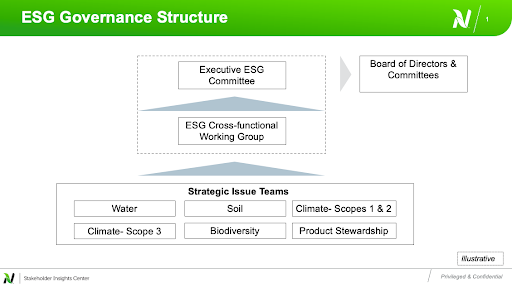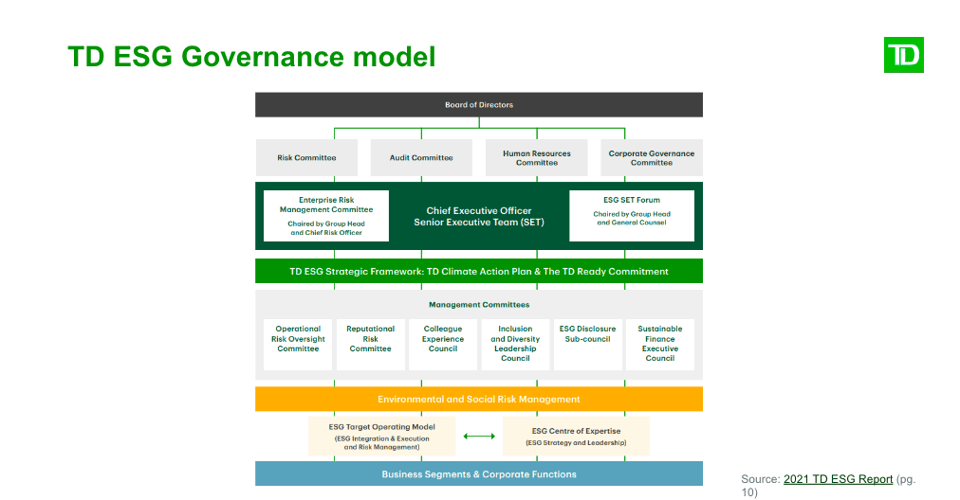6 min read
Building effective ESG governance
8 min read
Governance is an important pillar of ESG, and building a strong governance team is critical to delivering on your ESG strategy. How an organization is managed and operated, how it aligns with all stakeholder expectations, and what types of internal controls are in place to increase leadership transparency and accountability are key.
Donato Calace, SVP of Accounts & Innovation at Datamaran, hosted a webinar to discuss the issue of effective ESG governance. Joining him in the session and sharing their in-depth experience of the subject were Christine Rhodes, Associate Vice President, of ESG Reporting and Measurement at TD Bank, and Bill Cooper, Director of Issue and Reputation Management at Nutrien.
The team discusses best practices for establishing ESG governance in your business, you can follow each section of the webinar using the links in the headings.
Why ESG governance is needed
More and more companies are establishing Executive Committees to oversee ESG-related risks and opportunities. These require careful planning and the coordination of many moving parts, especially as ESG becomes increasingly trickier to navigate.
C-Suite needs to have a credible voice on a wide range of issues that go beyond compliance and anticipate the changing expectations of investors, employees, partners, and regulators.
That’s why more complex questions from leadership are piling up:
- “What are we allocating resources to and why?”
- “How are requirements around our key issues changing?”
- “What are the emerging risks for our company?”
- “Where is policy-making heading?”
- “Do we have any blindspots?”
Effectively addressing these questions is no longer a matter of presenting dashboards of ESG KPIs and ratings, or sharing the latest information from the most recent conference. It requires strategic foresight and the ability to base decisions on information that’s credible, relevant, and backed by data.
Evolving ESG legislation
On the subject of ESG governance, all eyes are focused on the new legislative requirements on the horizon:
- The IFRS is working on its first set of standards that should be finalized within the first half of 2023
- The US Securities Exchange Commission is likely to finalize its proposal on climate disclosure in April
- EFRAG submitted the European Sustainability Reporting Standards to the European Commission last November, and the European Commission is expected to transpose those into law in June 2020
All these standards have the same structure:
- Governance
- Strategy
- Risk Management
- Metrics and Targets
Increasing ESG regulation putting pressure on governance
Over the last 10 years the regulations addressing ESG governance have been increasing, both for voluntary and mandatory disclosures, this is a challenging issue to keep abreast of, Datamaran’s platform offers real-time analytics on strategic, regulatory and reputational risks, specific to your business and value chain.
Our database of the 8,000 largest companies worldwide by market cap shows a similar growing trend in terms of their awareness and responses.

TD Bank set up an ESG committee because it was a must have
Christine Rhodes explains that ESG has become so complex and stakeholders have high expectations, especially for publicly traded companies and companies in certain industries. It is now impossible for a single person or a siloed team within an organization to cope with the complexity and volume of the work involved.
The right business functions need to be coordinated as ESG is now so critical to business strategy, without this approach delivering on your ESG strategy is unlikely to be successful.
Nutrien set up an ESG committee for alignment and awareness
Bill Cooper explains that due to the growing complexity of ESG Nutrien wanted to bring together different parts of the business to inform strategy in an effective and impactful way - to make it core to their business.
This approach enables them to operationalize ESG and sustainability within the business, share knowledge, and build accountability.
What are the risks to your business if the ESG committee is not in place?
There is a risk of non-alignment, in larger more complex businesses and that risk grows exponentially with the size of the organization. Without ESG governance there is a significant chance that different operational units or functions will move in different directions; there is an increasing likelihood they may not be aware of something that could impact your business.
Addressing information to the right audiences is critical - executive committees have different requirements for lower-level working groups and specific functions within businesses. Bill Cooper discusses how Nutrien has learned to flex and pivot on these issues.
What ESG issues should be covered in governance committees?
The audience’s view on ESG committees was interesting.
What do you feel is not discussed enough in your ESG committees?-
- KPIs and ratings
- Progress on publicly announced goals and commitments
- Emerging ESG issues and ESG trends
Clearly, emerging ESG issues not being discussed enough was a key audience concern, so the panel discussed how to address this.
Technology supports good ESG governance
Nutrien uses Datamaran’s objective data for their ESG materiality analysis and to inform their executive team. TD Bank uses it for its ESG materiality analysis and to track emerging issues throughout the year.
Blueprints for an ESG governance committee?
Nutrien has a multi-level structure that addresses different issues, such as ESG strategy and targets.

TD Bank has a similar multi-level structure based on six different hubs based around business activities.

Both options have benefits and advantages, the optimum model for your business should be based on your decision-making flows.
Using external advisors on your ESG governance team
The focus is on internal issues, the ESG team liaises with external information providers and interprets them for the business. The internal ESG teams are trusted by the executive team, having developed their expertise the panelists explored why they no longer rely on external consultants.
Lessons for building your ESG governance
Make sure this structure is developed to just talk about these issues, you need to be able to demonstrate action and feed that back to everyone involved. Accountability, create a mandate for the group and get expectations on paper. Overall, focus on cadence and resource needs to successfully deliver this.
ESG is evolving at a fast pace, to keep you up to speed with the latest developments you can also download our e-book “The Ultimate Guide to Double Materiality - How to get started in 6 simple steps”, which explores regulatory requirements and best practices for conducting a double materiality assessment in 6 simple steps.

